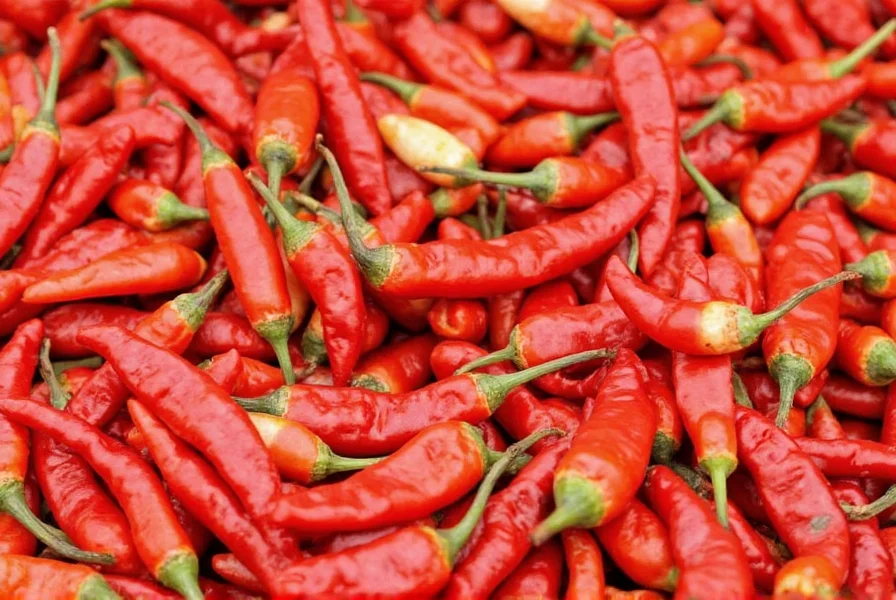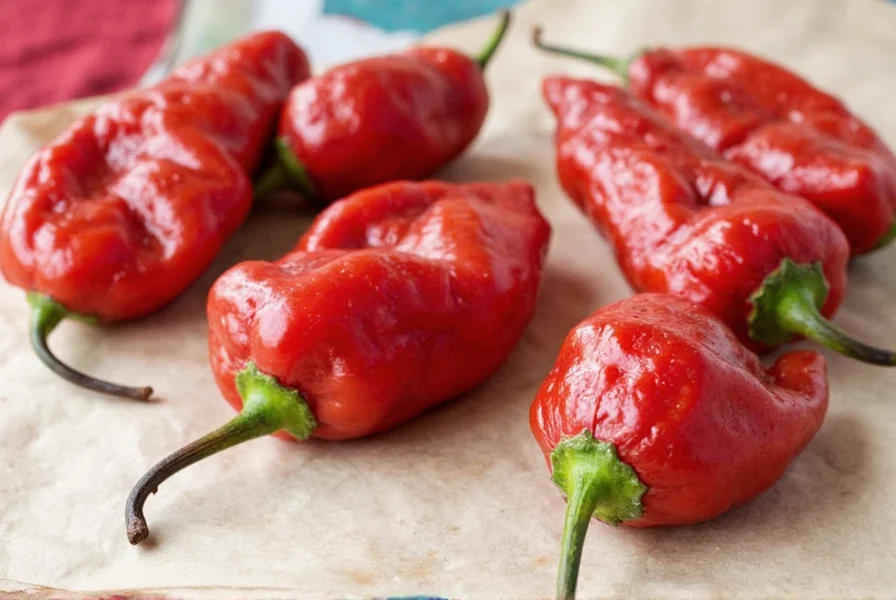Dry guajillo chiles are dried mirasol peppers (Capsicum annuum) commonly used in Mexican cuisine, with a medium heat level of 2,500–5,000 Scoville Heat Units (SHU) and fruity, tea-like flavor notes. They're essential for authentic moles, salsas, and marinades.
Table of Contents
- What Are Dry Guajillo Chiles?
- Heat Level & Flavor Profile
- 5 Pro Tips for Using Guajillo Chiles in Cooking
- Guajillo vs. Other Dried Chiles: A Visual Comparison
- Buying Guide: How to Choose the Best Guajillo Chiles
- Top 3 Recipes That Shine with Guajillo
- Frequently Asked Questions
- Final Thoughts
What Are Dry Guajillo Chiles?
Dry guajillo chiles are the dried form of the mirasol chili, one of the most widely used peppers in traditional Mexican cuisine. They're long, thin, and typically range from deep red to reddish-brown in color. Their versatility makes them a staple in salsas, marinades, soups, and sauces — especially moles and adobos.
Botanical Info
| Feature | Description |
|---|---|
| Scientific Name | Capsicum annuum |
| Origin | Mexico |
| Length | 4–6 inches |
| Heat Level | Medium (2,500–5,000 SHU) |
| Flavor Notes | Berries, tea, citrus peel, mild smokiness |
Heat Level & Flavor Profile
The charm of dry guajillo chiles lies not only in their manageable heat but also in their complex flavor notes. On the Scoville scale, they fall between 2,500 to 5,000 units — placing them right between a jalapeño and a serrano in terms of spiciness.
Flavor Breakdown
- Fruity: Think sun-dried tomatoes meets cranberries.
- Earthy: Subtle notes of forest floor or roasted herbs.
- Savory: A background hint of green bell pepper or dried mushroom.
- Tea-like: Some describe it as black tea leaves with a touch of tannin.
5 Pro Tips for Using Guajillo Chiles in Cooking
You don't have to be a chef to make magic with guajillo chiles. Here are five expert-approved tricks to get the most out of these flavorful pods:
- Toast Before Grinding: Lightly toast the chiles in a dry skillet until fragrant (about 30 seconds per side). This brings out deeper flavors without burning them.
- Rehydrate First: Soak them in hot water or broth for 20 minutes before blending. This softens them and unlocks their full flavor potential.
- Pair With Complementary Spices: Cumin, oregano, garlic, and cloves enhance guajillo's natural complexity.
- Make Your Own Adobo: Blend rehydrated guajillos with vinegar, salt, and spices to create a custom paste for rubs or marinades.
- Don't Skip the Seeds: For more heat and depth, keep some seeds in your mix unless you prefer milder results.
Guajillo vs. Other Dried Chiles: A Visual Comparison
To help you avoid confusion when shopping, here's a handy visual comparison chart of common dried chiles, focusing on appearance, heat level, and best uses.
| Chile Type | Color | Shape | Heat (SHU) | Flavor Notes | Best Use |
|---|---|---|---|---|---|
| Guajillo | Deep Red | Long and narrow | 2,500–5,000 | Fruity, tea-like, earthy | Moles, sauces, marinades |
| Ancho | Dark Red/Brown | Broad, flat | 1,000–2,000 | Sweet, raisin-like, mild | Moles, chocolate sauces |
| Arbol | Reddish Orange | Short and slender | 15,000–30,000 | Grassy, sharp, intense | Hot salsas, oils |
| Pasilla | Nearly Black | Long and wrinkled | 2,500–4,000 | Smoky, raisiny, prune-like | Moist sauces, soups |
| Chipotle | Tan to Brown | Smoked and wrinkled | 5,000–10,000 | Smoky, sweet, spicy | Barbecue sauces, stews |

Buying Guide: How to Choose the Best Guajillo Chiles
Not all guajillo chiles are created equal. Knowing what to look for can elevate your cooking game significantly. Here's how to shop smart:
Where to Buy
- Mexican Markets: Freshness is often better here than in supermarkets.
- Online Retailers: Look for organic, air-sealed packaging if buying online.
- Supermarkets: Available in Hispanic food sections; check expiration dates carefully.
What to Look For
| Feature | Good Sign | Avoid |
|---|---|---|
| Color | Bright red to reddish-brown | Faded or brownish-black |
| Texture | Firm yet pliable | Brittle or overly dry |
| Smell | Earthy, slightly fruity aroma | Moldy or musty scent |
Storage Tips
- Airtight Container: Store in a cool, dark place for up to 6 months.
- Freeze Them: Place in a ziplock bag and freeze for extended shelf life.
- Ground Option: Consider purchasing or grinding into powder for easy use in blends.
Top 3 Recipes That Shine with Guajillo
Dry guajillo chiles bring a balanced heat and depth of flavor that enhances many dishes. Here are three crowd-pleasing recipes where they really shine:
- Guajillo Salsa Roja
- Ingredients: Toasted guajillos, garlic, onion, tomato, cilantro.
- Best served with: Tacos, enchiladas, grilled meats.
- Guajillo Chicken Tinga
- Ingredients: Shredded chicken, chipotle in adobo, guajillo chiles, onion, garlic, tomato sauce.
- Perfect for: Tostadas, tacos de pita, or burritos.
- Classic Mole Poblano
- Key role: Blended with almonds, sesame seeds, cinnamon, and chocolate.
- Ideal occasion: Family gatherings, holidays, or potlucks.

Frequently Asked Questions
Still have questions? You're not alone! Here are some of the most common queries about dry guajillo chiles.
Are guajillo chiles spicy?
Yes, but not overly so. They pack a medium-level heat that builds slowly, making them great for those who want flavor with a kick, not fire.
Can I substitute guajillo chiles?
If needed, ancho or pasilla chiles can be substituted for a milder version, while adding a pinch of cayenne will mimic the heat of guajillo. For closest flavor match, try a combination of New Mexico chiles and a touch of paprika.
Do I remove the seeds?
That depends on your heat preference. Leaving some seeds in adds more spiciness and depth. Remove them entirely for a milder flavor. For authentic Mexican preparations, chefs often keep about 30-50% of the seeds for balanced heat.
Can I eat guajillo chiles whole?
While edible, they're quite tough and usually blended into sauces rather than eaten whole. Traditional Mexican cooking almost always involves rehydrating and blending guajillos into sauces or pastes.
How long do dried guajillo chiles maintain their flavor?
Properly stored in an airtight container in a cool, dark place, guajillo chiles retain optimal flavor for 6-12 months. Beyond that, they'll still be safe to eat but may lose some of their complex flavor notes and vibrant color. Freezing extends their peak flavor period to 18-24 months.
What's the best way to rehydrate guajillo chiles?
For maximum flavor extraction: 1) Remove stems and seeds (optional), 2) Place in a bowl, 3) Cover with hot water or broth (never boiling, as this can make them bitter), 4) Weight them down with a small plate to keep submerged, 5) Let soak for 15-20 minutes until pliable. For deeper flavor, add a bay leaf or garlic clove to the soaking liquid.
Why are my guajillo-based sauces turning out bitter?
Bitterness usually comes from three sources: 1) Over-toasting the chiles (30 seconds per side max in a dry skillet), 2) Using boiling water for rehydration (use hot but not boiling water), or 3) Leaving too many seeds and membranes which contain bitter compounds. For authentic sweet-bright guajillo flavor, balance with a touch of sugar or fruit.
Are guajillo chiles the same as California chiles?
No, though they're often confused. California chiles (sometimes called New Mexico chiles) are milder (500-2,500 SHU) with a more straightforward flavor profile, while guajillos have more complex fruity notes and slightly higher heat. California chiles are great for substitution when you want less heat, but they won't deliver the same nuanced flavor.
What traditional Mexican dishes absolutely require guajillo chiles?
Guajillos are essential in: Mole coloradito (a Oaxacan mole), Chile Colorado (a signature Northern Mexican stew), Salsa de Chile Guajillo (a foundational red sauce), and Carne Adobada (Mexican marinated meat). For authentic versions of these dishes, substituting other chiles significantly alters the traditional flavor profile.
Can I grow my own guajillo chiles?
Yes! While guajillo refers to the dried form, they come from mirasol peppers. These grow well in warm climates with long growing seasons. Plant seeds after last frost, provide full sun, and expect to harvest when peppers turn bright red and begin to wrinkle slightly (about 70-80 days). Dry them in a dehydrator or in a warm, dark place with good air circulation for 2-3 weeks.
Final Thoughts
Dry guajillo chiles are a gateway spice for anyone looking to explore the vibrant world of Mexican flavors. Their balance of heat, acidity, and complexity makes them incredibly versatile in the kitchen. Whether you're a seasoned cook or just starting your spice journey, guajillo chiles are worth keeping in your pantry.
So next time you see those slender red pods at the store, grab a handful — and maybe a few extra for experimentation. You'll soon discover why they've been a culinary favorite for centuries.
Happy cooking, and may your sauces be bold and your chiles always delicious!










 浙公网安备
33010002000092号
浙公网安备
33010002000092号 浙B2-20120091-4
浙B2-20120091-4